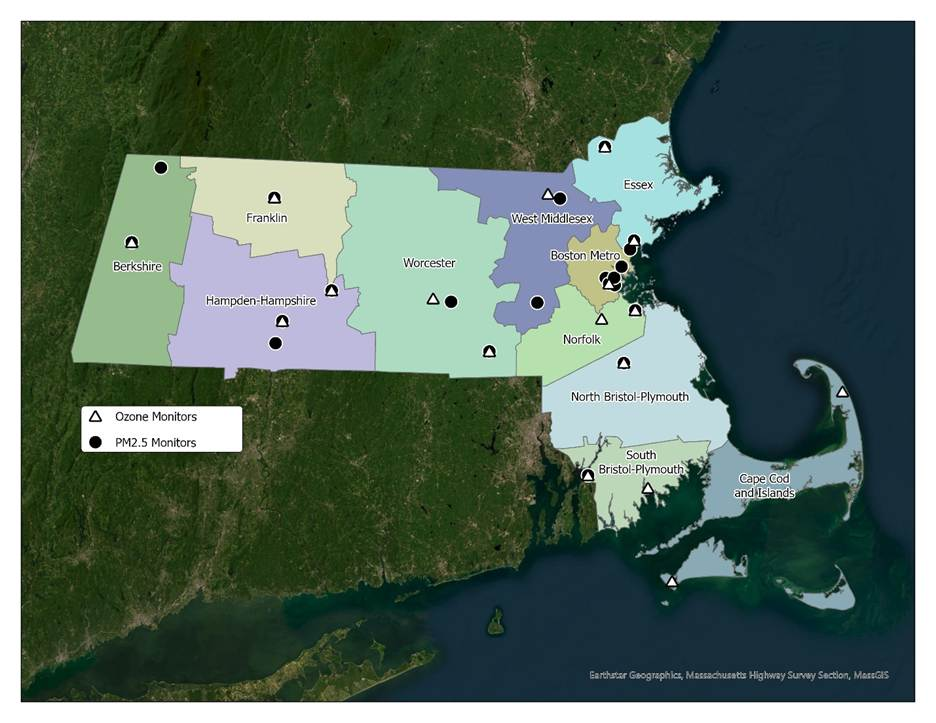Press Release: 11/24/2025
MassDEP Launches Two New Air Monitoring Stations
Agency Taking Proactive Steps to Ensure Cleaner Air by Implementing Stricter Standards, Upgrading Forecast Tools, and Offering Funding for Air Quality Sensors
FOR IMMEDIATE RELEASE:
11/24/2025
MEDIA CONTACT
Fabienne Alexis, Public Affairs Assistant Director / MassDEP
Phone
Call Fabienne Alexis, Public Affairs Assistant Director / MassDEP at 857-274-7522
Online
Email Fabienne Alexis, Public Affairs Assistant Director / MassDEP at fabienne.alexis@mass.gov
BOSTON — Today, the Massachusetts Department of Environmental Protection (MassDEP) announced the installation of two new air monitoring stations in Framingham and Saugus. These stations will identify and measure pollution levels from fine particulate matter (PM2.5) and black carbon. This is part of MassDEP’s broader, ongoing initiative to combat pollution and improve air quality across the state.
"Cleaner air means healthier communities and improved quality of life for everyone in the Commonwealth," said MassDEP Commissioner Bonnie Heiple. "By investing in air quality monitors and sensors, setting stricter standards, and updating our forecasts, we’re doubling down on our commitment to improving air quality."
MassDEP monitors air quality at 26 monitoring stations across the state, many of which have been strategically located in areas with higher pollution levels, asthma rates, and other risk factors. The agency provides daily air quality forecasts year-round for fine particulate matter (PM2.5) and, during the warmer summer months, for ozone. When pollution levels are forecast to exceed health-based standards, MassDEP issues air quality advisories. This past summer, MassDEP recorded six days with unhealthy ozone levels — four in June and two in August. Additionally, there were four days this year with unhealthy fine particulate levels, caused mostly by smoke from Canadian wildfires moving into Massachusetts.
The data collected by air monitors and sensors help inform regulatory updates. For example, in September 2025, MassDEP adopted a stricter standard for particulate pollution — often referred to as soot. This change tracks both data and scientific developments further demonstrating the harmful effects of fine particulate on public health, the environment, and the climate.
2025 Air Sensor Grants
MassDEP announced a new round of its Air Sensor Grant program in October 2025. A total of 370 air quality sensors is available for municipalities, Tribes, nonprofit organizations and community-based organizations. MassDEP will award up to five sensors to each grantee on a first-come, first-served basis until all sensors have been allocated.
The sensors measure fine particulate matter in the ambient air, and all data collected are publicly accessible in real time through EPA’s Fire and Smoke Map and the PurpleAir website.
Learn more about the program and apply here: MassDEP Air Sensor Grant.
Updating Forecast Tools
To improve air quality forecasts available to the public, MassDEP has updated the maps used by the AirNow and EnviroFlash systems. Air quality forecast regions have been better aligned with National Weather Service public forecast zones and have been given updated names, as depicted below.

Routine users of AirNow.gov will notice a change to most region names and AirNow app users may need to reset their saved Places.
EnviroFlash subscribers have been transitioned to the new forecast regions and were notified about the update through EnviroFlash. MassDEP recommends that all EnviroFlash subscribers review their account information to confirm their desired settings and chosen location.
MassDEP encourages Massachusetts residents who want up-to-date air quality forecasts to explore the many options available by visiting MassAir Online or AirNow.gov, downloading the AirNow app on their mobile devices, or signing up for EnviroFlash air quality notifications. Air quality forecasts are also available by calling the MassDEP Air Quality Hotline at 1-800-882-1497.
MassDEP provides daily air quality forecasts for fine particle pollution year-round and for ozone pollution during the summer ozone monitoring season through its MassAir Online website as well as through the AirNow website and app, and the EnviroFlash notification system.